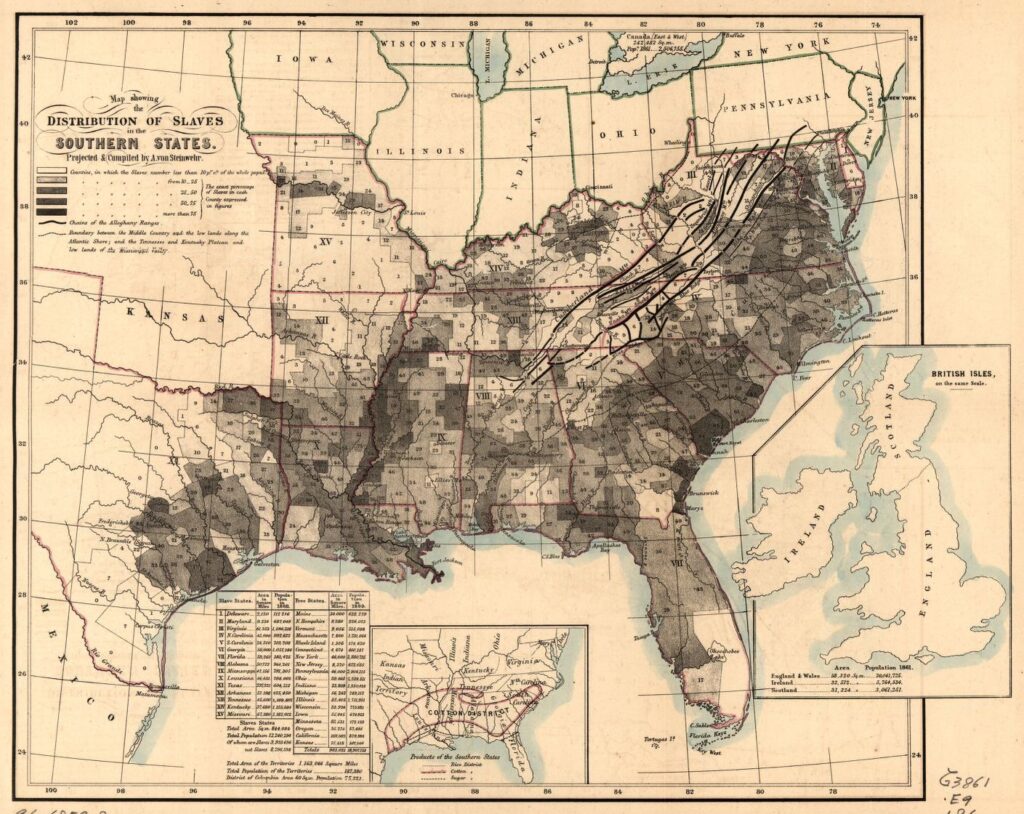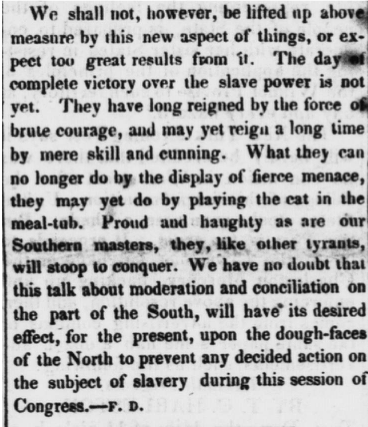
. [Philadelphia, Pa.?: A. von Steinwehr, 186-?] Map. https://www.loc.gov/item/96685918/.
The North Star focused heavily on the American South as a moral and political enemy to the worldview expressed by its editors and the abolitionist movement more broadly. The paper portrayed the South as a dangerous actor in the United States, one that undermined public morality to sustain its unjust system. The editors specifically pointed to ways that the South undermined norms like freedom of speech and the right to a fair trial, instead prioritizing the protection of slavery and the mistreatment of the enslaved. In the eyes of the editors, the South used its political power to maintain and expand slavery. Furthermore, state governments were portrayed as privileging enslavement over all other political beliefs. It’s important to note that while the paper paid lots of attention to the abuse, mistreatment, and enslavement that occurred in the South the editors also critiqued the inequality and racism of the North.
Topics and First Articles
The North Star sought to do two things in its depiction of the American South. First, it sought to display the horrors of enslavement and the experiences of enslaved people. On top of that the paper sought to show how the South, as a collective in the Senate and as individual states, sought to prioritize slavery over democratic principles like freedom of speech.
| States | states constitution south union congress slavery sir north state government question united power territory northern senate southern law vote great |
| Enslavement | slavery man men people free slaves country colored slave time years state made part rights make white subject states true |

Few topics make many direct mentions of the South exclusively. Instead, the topics often associate it with other states. The South also would have been heavily associated with enslavement, as the term “the Slave Power” was an insult used repeatedly by The North Star. One example of this term comes from an article written by Frederick Douglass in the January 12, 1849 edition of the paper. In this excerpt from an article titled “The Aspect of the Cause at Washington”, Douglass specifically emphasized the South as a “slave power” that would be undone just as some of the tyrants of Europe were being toppled in revolutions.
Looking at the words here, there is a clear connection between the North and South, but there are few words of judgement specifically pointed at the South in this framework. The words located here emphasize political struggles to abolish and prevent the spread of slavery, rather than critiques of the South. This does not mean that critiques focused at the South did not exist, the excerpts above clearly highlight a particular view of the South that used slavery as the basis of its political power. It may require a separate tool that looks more closely at how specific arguments were made.
The first articles demonstrate much of the North vs South dynamics that remained hidden in the topic analysis. Looking closely at the arguments utilized within The North Star, first articles emphasized how slavery benefitted those who held political power in the South. Out of the 136 articles that make up this sample, 36 included discussions that framed the issue of slavery as a competition between the North and the South. This was the largest single classification to come out of the first article analysis. Other articles discussed the relationship between slavery and government power 33 times throughout the available publications.
Looking at this group of articles by location offers other interesting conclusions. It clarifies how few first articles were based in the South. This is perhaps obvious for a newspaper whose chief editor had been formerly enslaved, but there were few reprints from other newspapers located there either, which was a popular way to spread information. It is important to keep in mind that the paper and these articles were political sources meant to argue a certain point. The American South was heavily associated with slavery, and the defense of it. Outside of supporters of slavery like John C. Calhoun, the South was rarely presented in its own voice.
Perhaps politics can explain some of these editorial choices. The Washington, D.C. in The North Star page includes a front-page article that argues against middle ground positions between abolition and slavery. With that context, it is possible to see this editorial choice as part of that philosophy. The two examples below demonstrate the way the South was presented, which sought to emphasize the very real evils of enslavement from perspectives that highlighted the anti-democratic actions of the American South as well as the mistreatment of enslaved people.
Example Articles
The American South: Enemy of Democracy
In the eyes of the paper, the political power of enslavers allowed them to make a mockery of democratic principles at both the local and national level. These articles portrayed the South as a dangerous place, one that valued the institution of enslavement over anything else. This article, written after his arrest, goes on to discuss the ways that enslavers dominated the politics of the state. While this had clear implications for who represented the state at the Federal level, it also had implications for representation within the state. The author argued: “But like all men born to station, or having it, these ‘Low countrymen’ have so worked the political machinery as too keep down the poor and the humble and pull up only the wealthy and the strong.”

The conclusion of this article states: “Judge ye, honest men, whether this is a despotism which yields, or whether it is not a despotism which must be met and made to know that wrongs of this will not be tolerated, and that Slavery itself, which feeds and fosters them, must not only be limited, but ANNIHILATED.” What about the treatment of J.M. Barrett has lead the author to argue this point? What perspectives are emphasized in this piece, and how would you categorize it?
Treatment of the Enslaved
Obviously, as an abolitionist newspaper, The North Star highlighted the cruelty of slavery. This article from the Louisville Examiner serves as an example of how the abolitionist community saw slavery and the violence that came with it. This particular article looked at the example of a Black man facing violent corporeal punishment for a crime without any form of trial. In looking at the actions of the judge in the case, the article also emphasized the discrimination faced by Black Americans throughout the United States. The article also highlighted the role of police and law enforcement in maintaining these unjust systems of oppression that harmed all people of color.

Conclusion
While The North Star was highly critical of enslavers and those in power in the American South, it was not their only target. As the section on Organizing in the Antebellum Era demonstrates, the paper campaigned against all forms of racial discrimination in the North as well as the South. With that in mind though, why target the South so specifically?
Looking at the results from the topic analysis and close reading, the answer may come down to the relationship between slavery and political power in the US Senate and other government bodies. The extent to which the South at the state and national levels protected the institution of slavery and those who profited from it made abolition a necessity in the eyes of Douglass and other advocates. Incidents like the imprisonment of J.M. Barrett emphasized to the abolitionist community that slavery and politics could not be cleanly separated. Political compromises that came with the U.S. Constitution allowed slavery to grow and remain a powerful force in American life. Even as racism continued to exist in both the North and South, the institution of slavery in the American South was seen as a moral and political threat of the highest order.
Today, most new research on slavery emphasizes its nearly universal existence in colonial America. The 1619 Project and other public-facing reckonings with race and racism have pointed out that large amounts of colonial-era wealth was born from the work of enslaved people. Slavery was an unavoidable part of early American political life in states like Massachusetts as well as Georgia and South Carolina. The North Star discusses the continual experience of racism in states like Massachusetts, but also clearly takes aim at the South for its union of enslavement and political power.